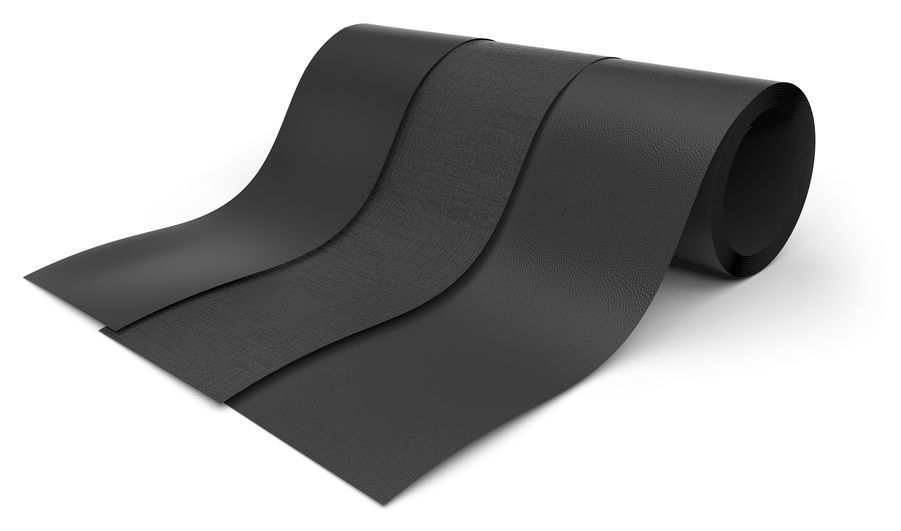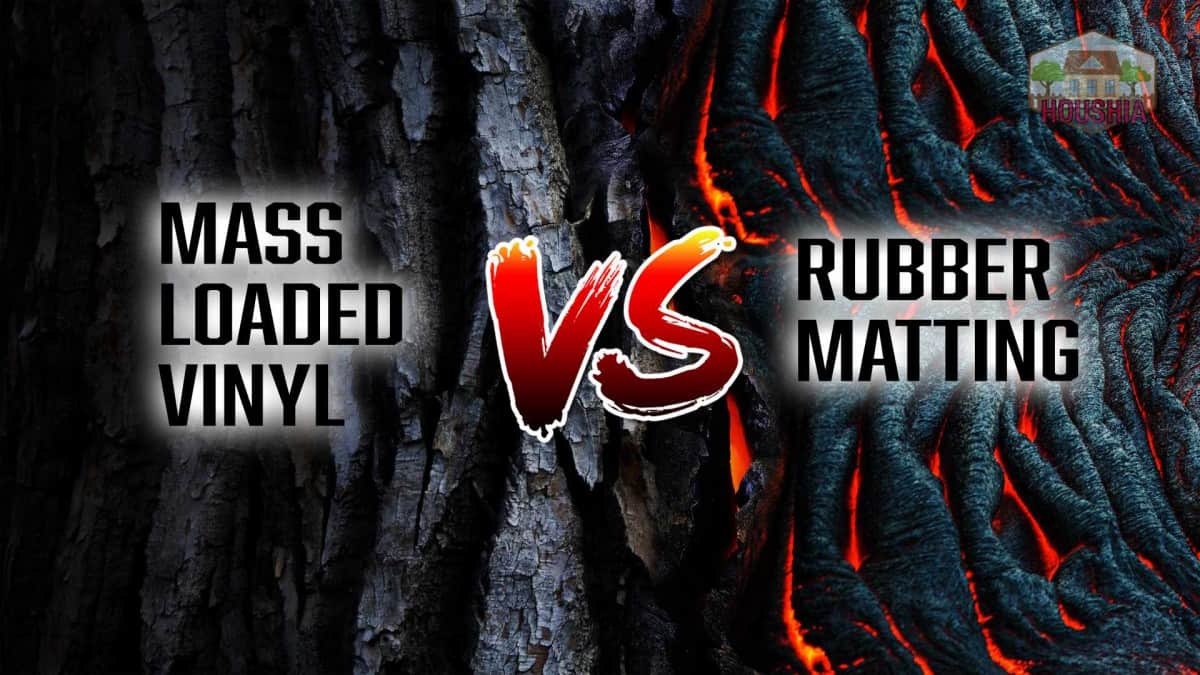Before MLV was introduced in construction back in the 1960s, the only way you can dampen noise from inside your home or outside is by thickening the walls of any structure.
However, even if MLV is the top performer for sound barriers, this item’s price can sometimes be too much for budget conscious buyers.
That’s where alternatives for MLV come in, and one of the most popular is the rubber mat.
What should I consider when choosing between MLV and rubber? How much it would cost to soundproof the area and its effectiveness are the main factors. Others are the availability of the item, the mode of installation (DIY or professional), and the purpose of your soundproofing needs.
After reading this article you’ll know the pros and cons of MLV vs Rubber matting and which one is best suited for difference scenarios.
So let’s get into it…
Budgetwise: MLV or Rubber Mats
From the countless forums I have trolled, the price of rubber mats can go anywhere from $1.30 – $2.40/ ft², while MLV would set you back anywhere from 1.5$ – 7.5$/ft².
Each material is sold via rolls or via tiles. The price would vary on the thickness and length of your choice.
The cheapest rubber mats you can find are those made from recycled tires. Goodyear carries these rubber mats under the name “ReUZ Rubber,” They are sold both in tiles and rolls.

A single rubber mat roll with the size of costs $65 without shipping cost. Tiles that measure 20″ x 20″ with a thickness of ¼ inch are sold in packs of four for $56, again without shipping.
MLV is mostly sold via rolls of different thicknesses, but the most commonly used is the ⅛ inch. Let’s take the Sonic-Shield Noise Barrier as our specific brand for MLV’s. It comes in ⅛ inch thickness and is sold in a 4.5ft x 30ft roll for $369 without a shipping fee.
When deciding between rubber and MLV, price is not the only factor you need to consider. A big one should be the performance or the effectiveness of the material.
It is common knowledge that when you go for alternatives, there will almost always be trade-offs. Sometimes it is the lifespan, the quality, and the effectiveness of the product.
MLV VS. Rubber Mats: Which is the most effective at reducing sound?
Rubber is dense by nature, and MLV is combined with a high-density or a high-mass element to achieve a weighted structure.
A rubber mat is more of a sound barrier than a sound absorber, so the thicker the rubber mat is, the better it is in blocking soundwaves.
MLV works the same way in the sense that the thicker it is, the better it performs. However, when you compare the weight per square foot of both, you’ll see that MLV has a more significant mass per square foot ratio.
Here is a table for better understanding. We’ll compare a ⅛” thick rubber matting and a ⅛” thick MLV.
| Sound Barrier | Thickness | Density/Weight |
| Rubber Mat Sheet | ⅛ inch | .58 lbs/ft² |
| MLV Sheet | ⅛ inch | 1 lb/ft² |
There are different uses for rubber mats. The most common would be floor underlayment, gym flooring, playground flooring, and many outdoor settings in your home or commercially.
MLV, on the other hand, is mostly used as a sound barrier. But since our topic is more of an acoustic nature, we will be looking at how rubber and MLV perform by looking at their STC rating.
First and foremost, STC or Sound Transmission Class is the standard unit of measure used by many professionals when soundproofing a building.
The higher the number you see in the rating, the more sound is blocked. This is the rating used for measuring the sound absorption and sound blocking capabilities of an MLV. Here is a quick reference guide for you to look at.
| STC Rating | |
| 25 | Normal conversation from another room can be heard and understood. |
| 30 | Loud conversation from another room can be heard and understood. |
| 35 | Loud conversation from another room can be heard but not understood. |
| 40 | Loud conversation can be faintly heard. |
| 45 | Conversations can’t be hard but traffic sounds and music can be heard. |
| 50 | Any loud sounds are heard faintly. |
| 60+ | Any sounds including traffic and music can’t be heard. |
A rubber mat does not have an STC rating.
However, since this material is used as a floor underlayment to reduce noise, it follows a different rating scale called IIC or Impact Insulation Class.
IIC is the rating system used to measure the ability to reduce the building floor or ceiling’s impact sound.
The same principle of the higher the number, the better the performance applies here. Take a look at this fun image for a better understanding.

As you begin to understand each rating’s meaning, you’ll easily be able to grasp the idea of how much soundproofing plays a significant role during the construction of buildings.
A 1lb MLV has an STC rating of 41-42, and a rubber floor underlay can bump up your ICC score to up to 60+.
Now you see how different rubber and MLV works. It is just like what I said all along MLV is a sound barrier and a sound absorber, while rubber is more of a sound dampener from impact noises.
Both Are Easy To Install
MLV is usually laid over the fiberglass installation and beneath the sheetrock.
It can also be installed on existing drywalls by stapling it up parallel to the wall, ensuring that you cover the wall from floor to ceiling. MLV can be installed on floors, ceilings, and walls.
Since MLV is very flexible, it is effortless to handle and maneuver around tight corners and hard to reach areas. It is easy to attach with staples, studs, or any fastener that would work for you.
Some MLVs come with adhesive on the back, so you can go right ahead and stick it on.
Rubber pretty much works the same way.
The only difference would be that rubber mats also come in tile forms cut in a jigsaw manner.
These pieces would fit perfectly with each other making a seamless joining possible.
It also comes in rolls with adhesive on the back, or you can buy spray-on adhesive.
That being said, keep in mind that rubber is less flexible than MLV and heavier so it’s not quite as easy to work with as MLV.
Lifespan of MLV And Rubber
MLV and rubbers have a long lifespan, especially if they are correctly installed.
Rubber mats last up to 10 years, maybe even more if you take care of them properly.
MLV could last anywhere between 20 – 30 years, depending on the quality of the brand. The choice depends on where you would be using the items.
Let’s look at the table below to see which took the cake in this comparison game.
| Cost | Effectiveness | Easy Installation | Lifespan | Perfect for: | |
| MLV | Sound Studio Setup, Game Room Setup, Home Entertainment Setup Cars RVs | ||||
| Rubber Mat | Gym setup, Machine noise dampener, vibration buffer between any surface and machine, floor underlay. |
Important Things to Note About MLV And Rubber Better
Mass loaded vinyl (MLV) is made from polyvinyl chloride (known as PVC) and a high-mass element, usually calcium carbonate or barium sulfate.
The vinyl content makes MLV flexible, and the high-mass part gives it its mass and density.
This is the perfect time to mention that the denser the material is, the more effective it is as a sound barrier.
On the other hand, natural rubber is made out of a substance that certain plants excrete when you cut into them. This liquid is called latex. This liquid is then processed into the different rubbers that we use today.
For this specific article, we will be looking closer into rubber mats since they are a popular alternative for MLV when it comes to soundproofing. Rubber mats can come from natural rubber or recycled rubbers like old tires.
To realize which one is more adept when it comes to soundproofing, we need to know a little bit about how sound works and how each material reacts to sound.
Like what I have mentioned before, MLV is both a sound barrier and a sound absorber. As a sound barrier, MLV prevents soundwaves from traveling any further.
It can also prevent the soundwaves from bouncing off walls, ceilings, and floors.
On the other side of the coin is the rubber mat. The way a rubber mat works is by dampening the sound that transfers from one surface to another.
Conclusion
Both MLV and rubber are used in soundproofing. It is better to look at the two separately than compare them because they work in different ways.
Use rubber floor underlay to lessen sound impacts on floors and ceilings, then use MLV on walls to add sound absorption and sound blocking aspects to inregular shapes and hard to reach places, such as sound dampening an RV for instance.
P.S.
That’s it for this article. I hope you enjoyed reading it and if you think it might be useful for someone else then please share it on social media, email or your own website! It really encourages us to write more content and grow the site!
If you’re interested in reading more about smart light, smart garages and smart homes checkout some of the other houshia categories including:

